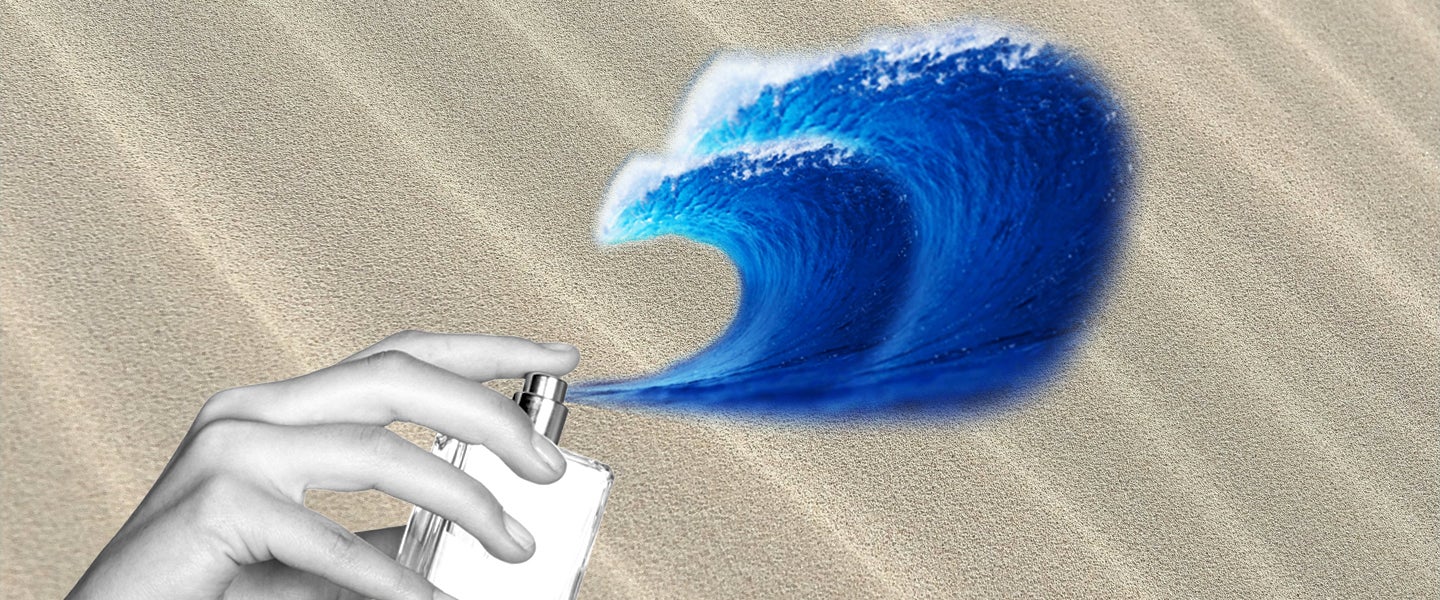There are two, categorically different scents of the ocean.
The first is the actual smell of the ocean, which scientists have long described as sulfuric. This — again, according to scientists — comes from bacteria that’s consuming decaying products and “producing a gas called dimethyl sulfide, or DMS, in places where plankton and marine plants such as seaweed were dying,” according to Andrew Johnston of the University of East Anglia, as reported by Live Science. “This pungent gas is what gives ocean air ‘sort of a fishy, tangy smell.’”
But more notable than the real smell of the ocean — because we’re a society that loves artificial mimicry, as demonstrated by grape-flavored anything — is the smell of the sea that’s usually sold as “ocean breeze” scented candles, deodorants and, most pervasively, “marine-scented” perfume. If you’ve ever basked in the artifice of this scented accoutrement, you know that while it doesn’t really smell like the ocean, it does evoke a certain coastal freshness that often borders on yacht-y arrogance.
This not-so-adjacent ocean smell is very in-demand, so much so that one redditor has embarked on a quest to find his ideal “holy grail marine scent.” “I’m most interested in evoking the experience of a day on the coast, the smell of the surf, the sea life, iodine, seaweed, ozone, brine, salt-spray rose and other dune plant life (not very sweet or heavily floral, but distinctively coastal flora), driftwood,” he writes. “Swimming in the sea and drying in the sun, digging in the sand, climbing the rocks.”
What’s more, his search includes a list of over 30 colognes that are oceanic — even if only in name — and he plans to spray through them all on his olfactory maritime adventure.
How, though, are these faux marine scents created?
According to Cordelia Running, a professor at Purdue University, whose research focuses on smells, brewing sought-after marine scents like these are part of the apprenticeship of a perfumer. “Perfumers apprentice for many years to become certified perfumists, and they have memorized various smell ingredients and components, their sensations and what happens when you mix certain aroma molecules together,” she says. “They mix/cook those ingredients together just like a chef would build a meal.”
Perfumer Christopher Gordon, from The Perfumer’s Studio in L.A., tells me that to create any scent, a perfumer will first sit down and start picturing the scene that the fragrance is meant to evoke. “Whether it’s a wild, windswept beach in Scotland or a warm, tropical beach in the Caribbean, that information will go a long way to help narrow down the materials and effects to be used.”
To that end, Gordon says that when people imagine the scent of an ocean breeze, “they usually think about what is being carried by the wind and a certain cooling freshness. There may be a green watery aspect, a hint of sunscreen and coconut and an airy ozonic effect.” To achieve the green watery aspect, most commonly associated with the scent of the beach, perfumers will use “something like seaweed, which can give a green, watery, mossy vibe,” says Gordon. “There is a material called Seaweed Absolute — it’s an extraction of seaweed and can be used to impart to the scent a green, watery, oceanic aspect.” Additionally, Gordon says that the air effects of marine-scented fragrances “are usually created using a synthetic aroma molecule known as Calone.”
Strangely, the molecule he’s referring to was actually discovered by Pfizer in 1966. “Calone produces the olfactory effect of a fresh seashore through intense marine and ozone notes. It also has slight floral overtones and watermelon rind undertones,” reports Byrdie.com. “Depending on the formulation, Calone may take on specific oceanic tones, such as green seaweed or algae.”
Most famously, according to Gordon, this scent was first popularized for men in 1988 by Davidoff’s “Cool Water” scent. “It’s the fragrance that started the trend for oceanic fragrances,” he says. “For women, it would probably be L’eau d’Issey by Issey Miyake, which is an aquatic floral. But there are lots of scents that fall into this family, like l’Eau by Kenzo and ‘Replica’ Beach Walk by Maison Martin Margiela.”
All of which is to say that the smell of the ocean, be it sulfuric or Margielic, is truly in the olfactory nerve of its wind-swept beholder.

